Subdeacon is a minor order or ministry for men in various branches of Christianity. The subdeacon has a specific liturgical role and is placed between the acolyte and the deacon in the order of precedence.

Divine Liturgy or Holy Liturgy is the Eucharistic service of the Byzantine Rite, developed from the Antiochene Rite of Christian liturgy which is that of the Ecumenical Patriarchate of Constantinople. As such, it is used in the Eastern Orthodox, the Byzantine Catholic Churches, and the Ukrainian Lutheran Church. Although the same term is sometimes applied in English to the Eucharistic service of Armenian Christians, both of the Armenian Apostolic Church and of the Armenian Catholic Church, they use in their own language a term meaning "holy offering" or "holy sacrifice". Other churches also treat "Divine Liturgy" simply as one of many names that can be used, but it is not their normal term.
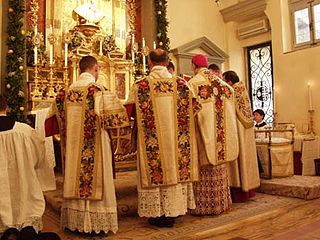
In the context of the Tridentine Mass of the Catholic Church, a Pontifical High Mass, also called Solemn Pontifical Mass, is a Solemn or High Mass celebrated by a bishop using certain prescribed ceremonies. The term is also used among Anglo-Catholic Anglicans. Although in modern English the word "pontifical" is almost exclusively associated with the Pope, any bishop may be properly called a pontiff. Thus, the celebrant of a Pontifical High Mass may be the pope or any bishop.
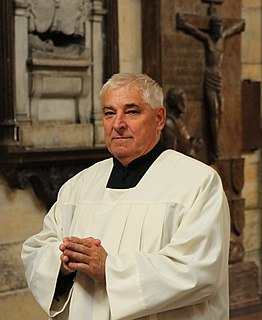
An altar server is a lay assistant to a member of the clergy during a Christian liturgy. An altar server attends to supporting tasks at the altar such as fetching and carrying, ringing the altar bell, helps bring up the gifts, brings up the book, among other things. If young, the server is commonly called an altar boy or altar girl. In some Christian denominations, altar servers are known as acolytes.

A thurible is a metal censer suspended from chains, in which incense is burned during worship services. It is used in Christian churches including the Roman Catholic, Eastern Orthodox, Assyrian Church of the East and Oriental Orthodox, as well as in some Lutheran, Old Catholic, United Methodist, Reformed, Presbyterian Church USA, Anglican churches. In Roman Catholic, Lutheran, and Anglican churches, the altar server who carries the thurible is called the thurifer. The practice is rooted in the earlier traditions of Judaism in the time of the Second Jewish Temple.

A Papal Mass is the Solemn Pontifical High Mass celebrated by the Pope. It is celebrated on such occasions as a papal coronation, an ex cathedra pronouncement, the canonization of a saint, on Easter or Christmas or other major feast days.

A flagon is a large leather, metal, glass, plastic or ceramic vessel, used for drink, whether this be water, ale, or another liquid. A flagon is typically of about 2 imperial pints (1.1 l) in volume, and it has either a handle, or one or two rings at the neck. Sometimes the neck has a large flange at the top rather than rings. The neck itself may or may not be formed into one, two or three spouts. The name comes from the same origin as the word "flask".

A lavabo is a device used to provide water for the washing of hands. It consists normally of an ewer or container of some kind to pour water, and a bowl to catch the water as it falls off the hands. In ecclesiastical usage it refers to all of: the basin in which the priest washes their hands; the ritual that surrounds this action in the Catholic Mass; and the architectural feature or fitting where a basin or place for one is recessed into the side wall of the sanctuary, or projects from it. If this last includes or included a drain, it is a piscina used for washing the church plate and other fittings, though the terms are often confused. In secular usage, it is an obsolete term for any sink or basin for washing hands, especially in a lavatory.
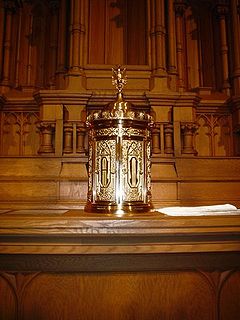
A tabernacle or sacrament house is a fixed, locked box in which the Eucharist is stored as part of the "reserved sacrament" rite. A container for the same purpose, which is set directly into a wall, is called an aumbry.

A paten or diskos is a small plate, used during the Mass. It is generally used during the liturgy itself, while the reserved sacrament are stored in the tabernacle in a ciborium.

The offertory is the part of a Eucharistic service when the bread and wine for use in the service are ceremonially placed on the altar.

An altar cloth is used in the Christian liturgy to cover the altar. It serves as a sign of reverence as well as a decoration and a protection of the altar and the sacred vessels. In the orthodox churches is covered by the antimension, which also contains the relics of saints.
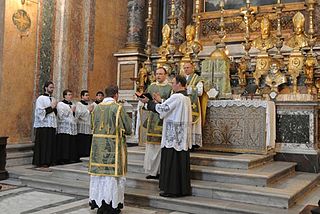
Solemn Mass is the full ceremonial form of the Tridentine Mass, celebrated by a priest with a deacon and a subdeacon, requiring most of the parts of the Mass to be sung, and the use of incense. It is also called High Mass or Solemn High Mass. However, in the United States the term "High Mass" is also used to describe the less elaborate Missa Cantata, which lacks a deacon and subdeacon and some of the ceremonies connected with them.
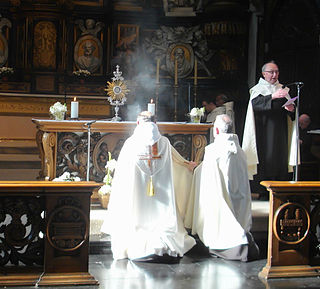
Benediction of the Blessed Sacrament, also called Benediction with the Blessed Sacrament or the Rite of Eucharistic Exposition and Benediction, is a devotional ceremony, celebrated especially in the Roman Catholic Church, but also in some other Christian traditions such as Anglo-Catholicism, whereby a bishop, priest, or a deacon blesses the congregation with the Eucharist at the end of a period of adoration.

Alexandrian rites are liturgical rites employed by three Oriental Orthodox churches, the Coptic Orthodox Church of Alexandria, Eritrean Orthodox Tewahedo Church, and Ethiopian Orthodox Tewahedo Church, as well as by their Eastern Catholic counterparts of the Coptic Catholic Church, Eritrean Catholic Church, and Ethiopian Catholic Church.

The Mass is the central liturgical rite in the Catholic Church, encompassing the Liturgy of the Word and the Liturgy of the Eucharist, where the bread and wine are consecrated and become the Body and Blood of Christ. As defined by the Church at the Council of Trent, in the Mass, "the same Christ who offered himself once in a bloody manner on the altar of the cross, is present and offered in an unbloody manner". The Church describes the Mass as the "source and summit of the Christian life". Thus the Church teaches that the Mass is a sacrifice. It teaches that the sacramental bread and wine, through consecration by an ordained priest, become the sacrificial body, blood, soul, and divinity of Christ as the sacrifice on Calvary made truly present once again on the altar. The Catholic Church permits only baptised members in the state of grace to receive Christ in the Eucharist.

In Eastern and Western Christian liturgical practice, the elevation is a ritual raising of the consecrated Sacred Body and Blood of Christ during the celebration of the Eucharist. The term is applied especially to that by which, in the Catholic Roman Rite of Mass, the Sacred Body of Christ (Host) and the chalice containing the Most Precious Blood of Christ are each lifted up and shown to the congregation immediately after each is consecrated. The term may also refer to a musical work played or sung at that time.
The Spoon is a liturgical implement used to distribute Holy Communion to the laity during the Divine Liturgy in some Eastern Christian rites.

Manuterge is the name given by the Roman Catholic Church to the towel used by the priest when engaged liturgically.

A communion-plate is a metal plate held under the chin of a communicant while receiving Holy Communion in the Catholic Church. Its use was common in the last part of the nineteenth century and during most of the twentieth.


















